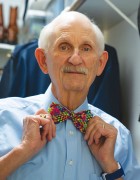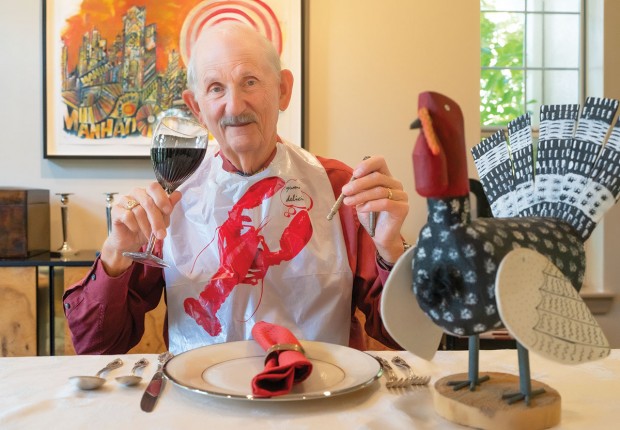Lobster at Thanksgiving?
Maybe not

My favorite Thanksgiving was in 1967. I was visiting my mother who lived in New York City at the time. She confessed to me that she really didn’t care for turkey, and I felt the same way. We went to a seafood restaurant where we treated ourselves to a very nice lobster dinner. My second favorite Thanksgiving dinner was in 1962 when I was a freshman in college in Boston. A friend invited me to his family’s Thanksgiving dinner. This was an Italian family in East Boston. The table was laid with a tiny turkey the size of a chicken, but for the 20 or so guests, there were huge bowls of linguini with marinara sauce, plates of arancini, sausages, eggplant parmesan, lasagna, and lots of bottles of Chianti.
When my wife and I have hosted Thanksgiving dinners, we’ve usually had a traditionally roasted turkey. Once, a friend invited me to bring my bird to his house, where he had a deep fryer. He set it up, but it wasn’t worth his while to cook just one turkey. So, various friends would arrive Thanksgiving morning, place their turkey in the fryer, and leave a half hour later with a cooked turkey. But then you had to make separate stuffing for the turkey even though it never really got stuffed.
My favorite turkey was years ago, after I took a trip to Italy with two friends and their wives. In Tuscany, the wives found out about a cooking class. We guys needed a little convincing, but we all decided to take the class from the Irish chef with the very Italian name – Seamus. In the class, Seamus taught us how to debone a chicken leaving only meat with intact skin. This is then rolled up with chard, grapes, and spices inside, and roasted in wine. I did this successfully on return to Houston, so that fall I thought it would be a good idea to try it on a turkey. I got a 20-pound bird and proceeded to debone it. After two and a half hours, my back hurt, but I had a turkey with no bones and intact skin. I rolled it up with herbs and grapes inside, and I cooked it in some cheap box wine. Yes, it was yum, but, well, I don’t think I’ll repeat this labor-intensive culinary feat.
How did Thanksgiving and turkey get linked in the first place? As children, we are told of the “first Thanksgiving” held with the Pilgrims thanking the local Indians for their help settling into the New World. There is actually some truth to that. One historical account exists. A Pilgrim leader named Edward Winslow wrote a letter describing life in the Plymouth colony of 1621. He records that the corn harvest was fine thanks to using the Indians’ method of growing corn by fertilizing it with a herring or shad. Winslow writes that the Wampanoag Indians were very loving, and they brought five deer for a thanksgiving feast. The Pilgrims supplied “fowl.” Historians believe this was not turkey but more likely duck or geese. So, there really was a 1621 feast consistent with the European tradition of a thanksgiving meal at harvest time. Many years would pass, however, before we had an official Thanksgiving holiday.
Sarah Josepha Hale wrote a novel, Northwood; a Tale of New England, in 1827. In it, she describes a New England thanksgiving meal with a turkey “at the head of the table.” One assumes the turkey was cooked. Ms. Hale campaigned for an official Thanksgiving holiday, and finally in 1863, Abraham Lincoln declared the last Thursday in November to be a national holiday of Thanksgiving.
But what of the turkey? How did it get to share its name with the nation occupying Anatolia? There are various stories about that, and Encyclopedia Britannica lists the most common. Guinea fowl from Madagascar were imported to Europe through Turkey and became known as “turkey cocks.” Our turkey looked a lot like the guinea fowl, so when the Mexican turkey (Meleagris ocellata) was imported to Spain in 1519, it looked like guinea fowl, and the name turkey was applied. The very similar North American bird (Meleagris gallopavo) was imported to Europe in the 1600s, and that is the turkey that graces our Thanksgiving tables today. By the way, the genus Meleagris was chosen in the 18th century because it meant guinea fowl in Greek.
In 1782 the bald eagle was designated our national bird. Two years later, Benjamin Franklin wrote a letter to his daughter, Sarah, in which he extolled the virtues of the turkey and panned the eagle as a “bird of bad moral character.” From this arose a legend that Franklin had proposed the turkey as our national bird. Well, he didn’t, but maybe the turkey would have been better.
In many ways, the turkey is a magnificent bird. For example, the forehead of the turkey has loose erectile tissue called a snood. Male turkeys sometimes spar with each other, and when they get excited, the snood, which hangs down about an inch, engorges with blood and may grow to as much as six inches. Male turkeys may fatally injure each other by lacerating an opponent’s engorged snood. To prevent that loss of turkey life, some farmers remove the snood from chicks, and that is called, should you want to know, “de-snooding.” Our national symbol, the bald eagle, may appear majestic as it swoops through the air or picks up some unsuspecting salmon, but does it have a snood? No.
Well, as for me, Thanksgiving will be here soon, and I guess I am in the minority for my preference of lobster over turkey. So, my guests will be served the traditional turkey as well as cranberry sauce and stuffing. Come to think of it, I just don’t know how to stuff a lobster...or do I?
Want more buzz like this? Sign up for our Morning Buzz emails.
To leave a comment, please log in or create an account with The Buzz Magazines, Disqus, Facebook, or Twitter. Or you may post as a guest.



